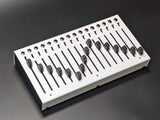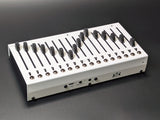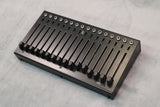*NEW* 2.1 Firmware! (Feb 2024)
- High Resolution mode for MIDI! 14bit Pitchbend on channels 1-16
Installation Notes: The new firmware must installed using the double-press of the reset button on the back of the module. The "reboot to bootloader" option on the editor is ONLY available for devices running 2.1 or later firmware. With the High Resolution mode enabled, BOTH TRS and USB MIDI send pitchbend on channels 1-16 and whatever CC mappings are assigned on the editor are disabled.
Download the 2.1 firmware New Feb 2024
Online parameter editor:https://misw.us/editor
To connect to the web editor, open the web page in a WebMIDI compatible browser, THEN connect the USB cable to the device. It will take several seconds to connect.XVI Desktop is a 16 channel desktop control surface.
Features:
- Long throw LED 60mm faders
- 0-5V, 0-10V, -5 to +5V CV ranges per channel
- USB Powered (USB C, Cable included)
- Fully analog CV outputs
- I2C communications as leader or follower
- 1x Fully buffered I2C Port for longer cable runs. (3.5mm TRS)
- USB MIDI and TRS A MIDI (can be used simultaneously with different mappings)
- I2C, MIDI, and CV can be used simultaneously
- Enclosure is 220mmx125mmx31mm
- Black case/Red LEDS, White Case/White LEDs. LEDs are user replaceable, different color LEDs available separately
- Includes: XVI Desktop Unit, 1.5m USB C to USB A Cable, 1.5m TRS A Midi to MIDI Cable
Item Dimensions: 23cm x 12cm x 4cm
IMPORTANT: This device requires a USC C 5V power supply which supplies 500mA or more (not included) for stand alone use. It is NOT recommend for use with passive USB hubs, only powered ones.
Other Important note: As of Serial#4161, all devices have TRS MIDI A. The spec has been official for a while now so all MiSW devices will conform to TRS MIDI A. Both types of cables will be available in the shop
Basic Usage instructions:
Front:
Voltage Select switches: Independent for each channel. Does NOT affect MIDI/I2C data
Back I/O:
USB: USB C connection for power and/or connection to computer. For use, simply connect to a 5V USB wall wart, 500 mA min (not included). The device is a class compliant MIDI device and requires no drivers.
I2C: Default State: Follower, Default Address: 0x31
PCB Rear:
Power backpack: This is the power supply for the device. When converting to the eurorack configuration simply remove. There is a standard 10pin power header below.

Includes 1.5m USB C Cable, 1.5m TRS A to DIN5 MIDI cable
Please Note:
This device uses PSIpower and has NO POLAIRTY on the power header, it can be installed EITHER WAY
UPGRADE INSTRUCTIONS FOR 1.xx Devices:
Download the 2.02 firmware New 1 November 2021
press the reset twice with USB connected, copy the firmware file to the folder that pops up, it will confirm and the window will close automatically.
The firmware is now unified for F8R and XVI, to identify the device as XVI, DIP switch #4 must be switched to ON
THIS REQUIRES OPENING THE UNIT TO ACCESS THE DIP SWITCH, please contact Michigan Synth Works if you need assistance with opening the device.
THE DIP SWITCH IS NOW DEPRCIATED, ALL FUNCTIONS IT SERVED ARE NOW DONE VIA WEB EDITOR. The ONLY function is serves now is to identify the unit as 16 channel instead of 8: if only 8 channels are showing up in the editor that means you did not switch DIP channel #4 to on. Mid 2021+ Devices do NOT have this switch
FIRMWARE UPDATES:
Firmware update procedure: Connect the Mini USB to your computer and press the blue reset button on the back of the module twice (quickly), it is accessible through a small hole in the desktop version. A new drive will appear on your computer, simply copy the firmware file to that drive (it will give you a warning about copying a file without properties). The drive will disappear once the file is copied and the module will reboot with the new firmware.

CURRENT FIRMWARE VERSION: 2.03
Available Here
PLEASE NOTE, THE WEBSITE INCORRECTLY IDENTIFIES THE FIRMWARE VERSION, THE VERSION YOUR DEVICE SHIPPED WITH IS ON THE BOX LABEL
Open Source Licenses:
UF2 Bootloader designed by Adafruit Industries and released under the MIT License
Portions of the code used for this device come from the 16n Faderbank by Brian Crabtree, Tom Armitage, and Brendon Cassidy released under the MIT License

















